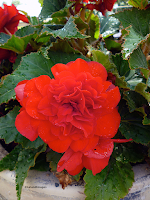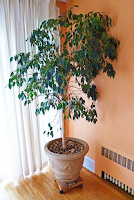 Don’t those cool breezes feel fabulous? Today I saw the first “V” of geese high in the sky, their voices echoing through the trees through the neighborhood. Fall is my favorite season, a panorama of color and change as the earth prepares to rest for a while. But not for us gardeners! We’ve enjoyed the fruits of our labor all summer, and now it’s time to clean up after the party.
Don’t those cool breezes feel fabulous? Today I saw the first “V” of geese high in the sky, their voices echoing through the trees through the neighborhood. Fall is my favorite season, a panorama of color and change as the earth prepares to rest for a while. But not for us gardeners! We’ve enjoyed the fruits of our labor all summer, and now it’s time to clean up after the party.If you haven’t done so already, get those hardy spring flowering bulbs into the ground: tulips, daffodils, hyacinths, and the like should
be planted now. To protect these tasty morsels from rodents through the winter, try placing barricades over the planting site, using chicken wire or hardware cloth, old window screens, boards, or plant saucers weighted down with rocks. Several bulb-dip products also claim to repel pests.
 While you’re rooting around in the soil, dig your tender bulbs and tubers, and give them a chance to dry a little before storing them. Gladiola, dahlias, begonias, and cannas need to be out of the ground
While you’re rooting around in the soil, dig your tender bulbs and tubers, and give them a chance to dry a little before storing them. Gladiola, dahlias, begonias, and cannas need to be out of the groundbefore it freezes. Ideally, the foliage should be yellow and withering by now; cut off the stalks to about 8 inches above the bulb/tuber/corm, then place in a dry location for about 2 weeks. When the stalk is completely dry, knock off any remaining soil from the bulb/tuber/corm, and store in a cool (not cold) dry place for the winter. Begonias and dahlias should be stored in slightly moist peat moss; gladiolus corms can be simply placed in a paper bag. Canna tubers should be lightly wrapped in newspaper and loosely packed in paper bags.
 Did you give your houseplants a summer vacation on the porch or in the garden? If so, bring them in right now! The longer they stay outside this month, the harder the shock when they are moved
Did you give your houseplants a summer vacation on the porch or in the garden? If so, bring them in right now! The longer they stay outside this month, the harder the shock when they are moved indoors. If they’ve been out in the open, move them to a sheltered spot (a covered porch or deck) for a day or two. Check them for insects–especially whiteflies–and, if need be, spray with organic insecticidal soap to eliminate any pests.
If you’re like me, you couldn’t resist those huge exotic tropicals that
 grow and bloom profusely. Bougainvillea, mandevilla, banana plants, elephant ear–gorgeous, but sadly not winter hardy here. Want to try your hand at keeping them? You might have some luck with one of the following: 1) if you have a sunroom or heated greenhouse, the plant will maintain active growth; 2) try taking cuttings to root for new plants in the spring; or 3) put the plant in a cool dark place and allow it to go dormant.
grow and bloom profusely. Bougainvillea, mandevilla, banana plants, elephant ear–gorgeous, but sadly not winter hardy here. Want to try your hand at keeping them? You might have some luck with one of the following: 1) if you have a sunroom or heated greenhouse, the plant will maintain active growth; 2) try taking cuttings to root for new plants in the spring; or 3) put the plant in a cool dark place and allow it to go dormant. Once you’ve taken care of the individual plants that need special attention, it’s time to focus on the more general chores. Continue to water any new plantings or perennials that were divided and moved last month; remember your shrubs and young trees, as well. Continue mowing as long as the grass is growing. If you can, reseed and repair dead areas as we go into what is hopefully the rainy season. Another round of weeding will help your landscape’s appearance, as well as stave off Nature’s last efforts to reseed for spring. And lastly, clean leaves and debris from your flower beds and lawn. Slugs and other undesirables hibernate under this dark, moist decaying matter, and clumps of leaves left on turfgrass will kill it, leaving ideal places for weed seed to take up residence.
Think you’re finished? Not yet–clean and store your garden tools so they’ll be sharp and in good working order next spring. It’s a good idea to get into the habit of cleaning tools on a regular basis throughout the season. After each use, remove soil from digging tools; moisture in the soil will rust and pit the metal cutting surfaces. If you wash your tools, dry them thoroughly before storing. Keep an oily rag in your garden tote to wipe down pruners, loppers, shears, and clippers after each use. Before storing for the winter, rub linseed oil into the wooden handles of your rakes, shovels, and hoes; spray or wipe the metal parts with either household oil or a lubricant like WD-40®. When spring comes, you’ll be glad you did all this in the fall.
And now, you can curl up with a good gardening book!




No comments:
Post a Comment